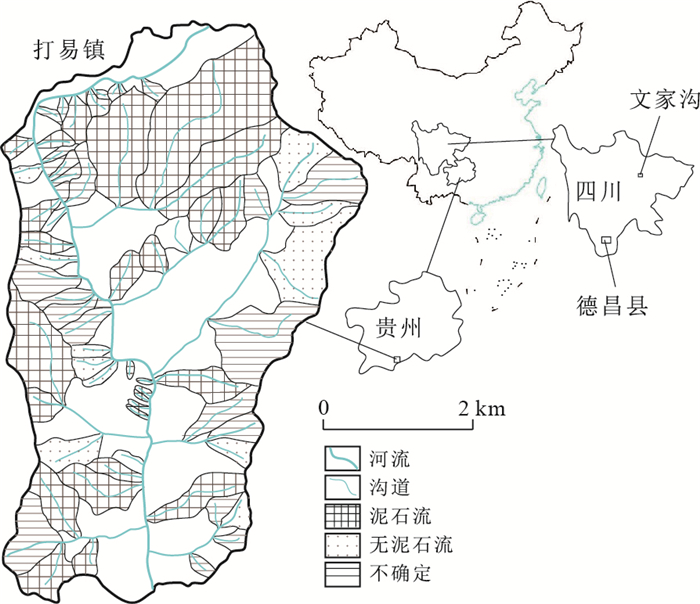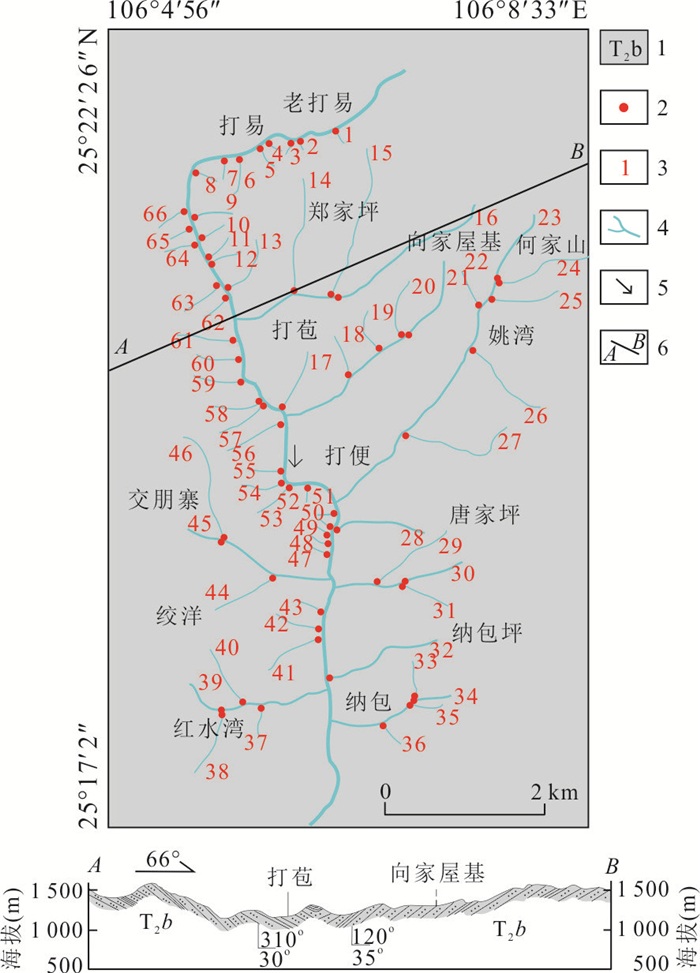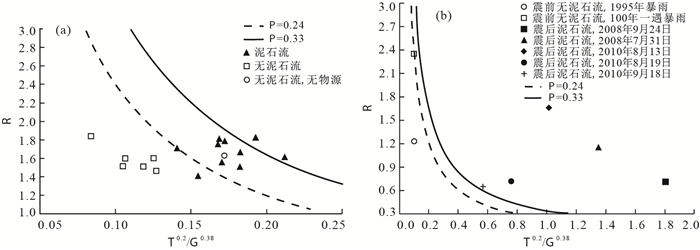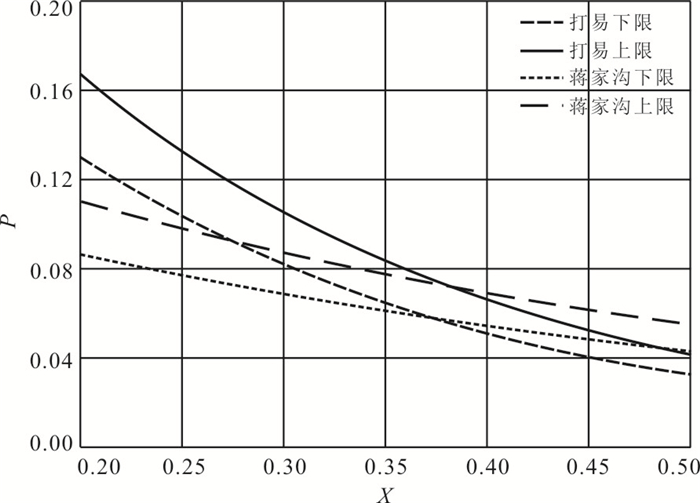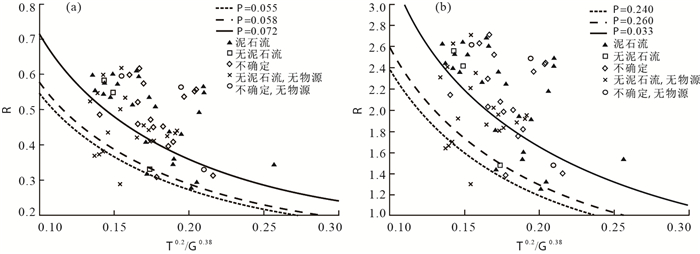A Precise Prediction Model on Debris Flows Caused by Runoff Mechanism Based on Channel Width and Particle Size
-
摘要: 泥石流形成区沟床宽度和颗粒粒径对沟床起动型泥石流的发生影响很大,在强烈地震影响区内显得尤为突出,但目前的泥石流预报中还没考虑到这两个因素,无法准确预测强震区泥石流的发生.在泥石流10 min和1 h精细化预报模型基础上,通过现场调查群发泥石流事件,结合汶川地震强烈影响区泥石流的演化特点,引入了泥石流形成区沟道宽度和颗粒粒径的影响,建立了改进的精细化泥石流10 min和1 h预报模型,并在贵州望谟打易和四川德昌群发泥石流、汶川地震强烈影响区的文家沟多次泥石流事件中获得了很好的验证结果,得出泥石流形成区的颗粒粒径代表泥石流的地质因子,泥石流形成区沟床宽度代表泥石流的地形因子之一,这2个因子在泥石流发生中的作用都非常重要;改进的精细化10 min和1 h预报模型以及临界值,可以用于强烈地震区和一般的泥石流预报.Abstract: The channel width and particle size in the formation area of debris flow catchment are important factors in the initiation of debris flows caused by runoff mechanism. This phenomenon is often found in the debris flows in strong earthquake area. Up to now, there is no prediction model of debris flow involving these two factors. Based on the 10 min and 1 h precise prediction model of debris flow, this study proposes a revised 10 min and 1 h precise prediction model of debris flow with channel width and particle size by field investigations. The validations were made in the group debris flow events of Dayi, Wangmo County, Guizhou Province, in the group debris flow events of Dechang, Sichuan Province, and a series debris flows in Wenjia Gully located in the Wenchuan earthquake area. The validations were successful in these debris flows events. It is concluded that the particle size in the formation area of debris flow catchment is the geological factor, and the channel width of the formation area of debris flow catchment is one of the topographical factor. Both of them are very important in the formation of debris flows. The revised 10 min and 1 h precise prediction model of debris flows can be used for forecasting of the ordinary debris flows and debris flows in strong earthquake area.
-
Key words:
- debris flow /
- runoff /
- channel width /
- particle size /
- disaster prediction
-
表 1 改进模型与原模型预测结果在打易和德昌泥石流的对比
Table 1. The comparison of prediction of revised model and the old model in debris flows of Dayi and Dechang
地域 模型 泥石流 无泥石流 绿色* 橙色# 红色@ 绿色 橙色 红色 打易 原模型10 min 0 5 19 10 3 9 改进模型10 min 0 6 18 19 1 2 打易 原模型1 h 0 5 9 10 3 9 改进模型1 h 0 6 18 19 1 2 德昌 原模型1 h 1 3 6 3 4 0 改进模型1 h 1 7 2 7 0 0 注:“*”表示低临界值以下,安全区;“#”表示高、低临界值之间,警报区;“@”表示高临界值以上,避难区;表中数字指位于该区域内的预测点个数. 表 2 文家沟降雨特征
Table 2. The characteristics of rainfall at Wenjia Gully
时间 总降雨量(mm) 最大小时降雨量(mm) 泥石流发生 2008-09-24 88.0 30.5 是 2010-07-31 60.2 51.7 是 2010-08-13 185.9 70.6 是 2010-08-19 72.6 31.9 是 2010-09-18 52.0 29.0 是 1995-08-15 496.5* 49.8 否 100年一遇 474.0* 95.0 否 注:“*”表示24 h降雨量. -
Chen, H. X., Zhang, L. M., Zhang, S., 2014. Evolution of Debris Flow Properties and Physical Interactions in Debris-Flow Mixtures in the Wenchuan Earthquake Zone. Engineering Geology, 182:136-147. https://doi.org/10.1016/j.enggeo.2014.08.004 Fan, R. L., Zhang, L. M., Wang, H. J., et al., 2018. Evolution of Debris Flow Activities in Gaojiagou Ravine during 2008-2016 after the Wenchuan Earthquake. Engineering Geology, 235:1-10. https://doi.org/10.1016/j.enggeo.2018.01.017 Kean, J. W., Staley, D. M., Cannon, S. H., 2011. In Situ Measurements of Post-Fire Debris Flows in Southern California:Comparisons of the Timing and Magnitude of 24 Debris-Flow Events with Rainfall and Soil Moisture Conditions. Journal of Geophysical Research, 116(F4):F04019. https://doi.org/10.1029/2011jf002005 Li, F., Mei, H.B., Wang, W.S., et al., 2017.Rainfall-Induced Meteorological Early Warning of Geo-Hazards Model:Application to the Monitoring Demonstration Area in Honghe Prefecture, Yunnan Province. Earth Science, 42(9):1637-1646(in Chinese with English abstract). McGuire, L. A., Rengers, F. K., Kean, J. W., et al., 2017. Debris Flow Initiation by Runoff in a Recently Burned Basin:Is Grain-by-Grain Sediment Bulking or En Masse Failure to Blame?. Geophysical Research Letters, 44(14):7310-7319. https://doi.org/10.1002/2017gl074243 Ni, H.Y., Tang, C., 2014.Advances in the Physical Simulation Experiment on Debris Flow Initiation in China.Advances in Water Science, 25(4):606-613(in Chinese with English abstract). http://d.old.wanfangdata.com.cn/Periodical/skxjz201404017 Shieh, C. L., Chen, Y. S., Tsai, Y. J., et al., 2009. Variability in Rainfall Threshold for Debris Flow after the Chi-Chi Earthquake in Central Taiwan, China. International Journal of Sediment Research, 24(2):177-188. https://doi.org/10.1016/s1001-6279(09)60025-1 Su, P.C., Wei, F.Q., Gu, L.K., et al., 2010.Characteristic and Causes of Group-Occurring Debris Flow in Dechang County, Sichuan Province.Journal of Mountain Science, 28(5):593-606(in Chinese with English abstract). http://www.wanfangdata.com.cn/details/detail.do?_type=perio&id=sdxb201005013 van Asch, T.W.J., Yu, B., Hu, W., 2018. The Development of a 1-D Integrated Hydro-Mechanical Model Based on Flume Tests to Unravel Different Hydrological Triggering Processes of Debris Flows. Water, 10(7):950. https://doi.org/10.3390/w10070950 Wang, T., Shi, J.S., Wu, S.R., et al., 2010.Formation Mechanism of Wenjiagou High-Speed and Long-Runout Debris Avalanche Triggered by Wenchuan Earthquake. Journal of Engineering Geology, 18(5):631-644(in Chinese with English abstract). http://www.wanfangdata.com.cn/details/detail.do?_type=perio&id=gcdzxb201005005 Wang, Y.M., Yin, K.L., 2018. Initiating Mechanism of Typhoon-Triggered Debris Flow. Earth Science, 43 (Suppl. 2):263-270 (in Chinese with English abstract). Wu, J.S., Kang, Z.C., Tian, L.Q., et al., 1990. The Observation and Research on Debris Flows in Jiangjia Gully, Yunnan Province. Science Press, Beijing (in Chinese). Xu, Y.L., 1996. The Formation Mechanism and Prevention of Debris Flow in Dechang Area of the Railway Line between Chengdu and Kunming. The Railway Engineering, (5):21-24 (in Chinese). Xu, Q., 2010.The 13 August 2010 Catastrophic Debris Flows in Sichuan Province:Characteristics, Genetic Mechanism and Suggestions. Journal of Engineering Geology, 18(5):596-608(in Chinese with English abstract). http://cn.bing.com/academic/profile?id=a9745750def798fd0d06ae23f61bce5a&encoded=0&v=paper_preview&mkt=zh-cn Yang, F.R., Zhou, H.W., Huo, M., et al., 2016.Rainfall Induced Debris Flow Characteristics and Mechanisms of Plagues after the Outbreak of the Earthquake in Wenchuan. China Rural Water and Hydropower, 12:38-42, 48(in Chinese with English abstract). http://www.wanfangdata.com.cn/details/detail.do?_type=perio&id=zgncslsd201612009 Yu, B., 2011. Research on Prediction of Debris Flows Triggered in Channels. Natural Hazards, 58(1):391-406. https://doi.org/10.1007/s11069-010-9673-8 Yu, B., Ma, Y., Wu, Y.F., et al., 2010.Investigation of Severe Debris Flow Hazards in Wenjia Gully of Sichuan Province after the Wenchuan Earthquake.Journal of Engineering Geology, 18(6):827-836(in Chinese with English abstract). http://www.wanfangdata.com.cn/details/detail.do?_type=perio&id=gcdzxb201006003 Yu, B., Wang, T., Zhu, Y., et al., 2016.Research on the Topographical and Rainfall Factors of Debris Flows Caused by Shallow Landslides. Advances in Water Science, 27(4):542-550(in Chinese with English abstract). http://www.wanfangdata.com.cn/details/detail.do?_type=perio&id=skxjz201604008 Yu, B., Wu, Y. F., Chu, S. M., 2014. Preliminary Study of the Effect of Earthquakes on the Rainfall Threshold of Debris Flows. Engineering Geology, 182:130-135. https://doi.org/10.1016/j.enggeo.2014.04.007 Yu, B., Zhu, Y., Wang, T., et al., 2014.Prediction Model for Occurrence of Debris Flows in Channels with Runoff Initiation Mechanism. Journal of Engineering Geology, 22(3):450-455(in Chinese with English abstract). http://www.wanfangdata.com.cn/details/detail.do?_type=perio&id=gcdzxb201403018 Yu, B., Zhu, Y., Wang, T., et al., 2015.Research on the 10-Minute Rainfall Prediction Model for Debris Flows. Advances in Water Science, 26(3):347-355(in Chinese with English abstract). http://d.old.wanfangdata.com.cn/Periodical/skxjz201503006 Yu, B., Zhu, Y.B., Liu, Y., et al., 2017.Prediction Model of Hillslope Debris Flows. Advances in Water Science, 28(6):839-848(in Chinese with English abstract). Zhang, S., Zhang, L. M., 2017. Impact of the 2008 Wenchuan Earthquake in China on Subsequent Long-Term Debris Flow Activities in the Epicentral Area. Geomorphology, 276:86-103. https://doi.org/10.1016/j.geomorph.2016.10.009 Zhou, W., Tang, C., 2013.Rainfall Thresholds for Debris Flows Occurrence in the Wenchuan Earthquake Area. Advances in Water Science, 24(6):786-793(in Chinese with English abstract). http://d.old.wanfangdata.com.cn/Periodical/skxjz201306004 Zhou, W., Tang, C., Zhou, C.H., et al., 2012.Critical Rainfall Characteristics for Rainfall-Induced Debris Flows in Wenchuan Earthquake Affected Areas. Advances in Water Science, 23(5):650-655(in Chinese with English abstract). http://d.old.wanfangdata.com.cn/Periodical/skxjz201205008 李芳, 梅红波, 王伟森, 等, 2017.降雨诱发的地质灾害气象风险预警模型:以云南省红河州监测示范区为例.地球科学, 42(9):1637-1646. doi: 10.3799/dqkx.2017.112 倪化勇, 唐川, 2014.中国泥石流起动物理模拟试验研究进展.水科学进展, 25(4):606-613. http://www.wanfangdata.com.cn/details/detail.do?_type=perio&id=skxjz201404017 苏鹏程, 韦方强, 顾林康, 等, 2010.四川省德昌县群发性泥石流的特征和成因.山地学报, 28(5):593-606. doi: 10.3969/j.issn.1008-2786.2010.05.013 王涛, 石菊松, 吴树仁, 等, 2010.汶川地震触发文家沟高速远程滑坡-碎屑流成因机理分析.工程地质学报, 18(5):631-644. doi: 10.3969/j.issn.1004-9665.2010.05.005 王一鸣, 殷坤龙, 2018.台风暴雨型泥石流启动机制.地球科学, 43 (Suppl. 2):263-270. 吴积善, 康志成, 田连权等, 1990.云南蒋家沟泥石流观测研究, 北京:科学出版社, 1-3. 徐永良, 1996.成昆线德昌地区泥石流成因及防治.铁道建筑, (5):21-24. http://www.wanfangdata.com.cn/details/detail.do?_type=perio&id=QK199600812018 许强, 2010.四川省8·13特大泥石流灾害特点、成因与启示.工程地质学报, 18(5):596-608. doi: 10.3969/j.issn.1004-9665.2010.05.002 杨丰荣, 周宏伟, 霍苗, 等, 2016.汶川震后降雨诱发型泥石流特征及成灾机理.中国农村水利水电, 2016(12):38-42, 48. doi: 10.3969/j.issn.1007-2284.2016.12.009 余斌, 马煜, 吴雨夫, 等, 2010.汶川地震后四川省绵竹市清平乡文家沟泥石流灾害调查研究.工程地质学报, 18(6):827-836. doi: 10.3969/j.issn.1004-9665.2010.06.003 余斌, 王涛, 朱渊, 等, 2016.浅层滑坡诱发沟谷泥石流的地形和降雨条件.水科学进展, 27(4):542-550. http://d.old.wanfangdata.com.cn/Periodical/skxjz201604008 余斌, 朱渊, 王涛, 等, 2014.沟床起动型泥石流预报研究.工程地质学报, 22(3):450-455. http://d.old.wanfangdata.com.cn/Periodical/gcdzxb201403018 余斌, 朱渊, 王涛, 等, 2015.沟床起动型泥石流的10 min降雨预报模型.水科学进展, 26(3):347-355. http://d.old.wanfangdata.com.cn/Periodical/skxjz201503006 余斌, 朱云波, 刘秧, 等, 2017.坡面泥石流降雨预报模型.水科学进展, 28(6):839-848. http://d.old.wanfangdata.com.cn/Periodical/skxjz201706005 周伟, 唐川, 2013.汶川震区暴雨泥石流发生的降雨阈值.水科学进展, 24(6):786-793. http://d.old.wanfangdata.com.cn/Periodical/skxjz201306004 周伟, 唐川, 周春花, 等, 2012.汶川震区暴雨泥石流激发雨量特征.水科学进展, 23(5):650-655. http://d.old.wanfangdata.com.cn/Periodical/skxjz201205008 -









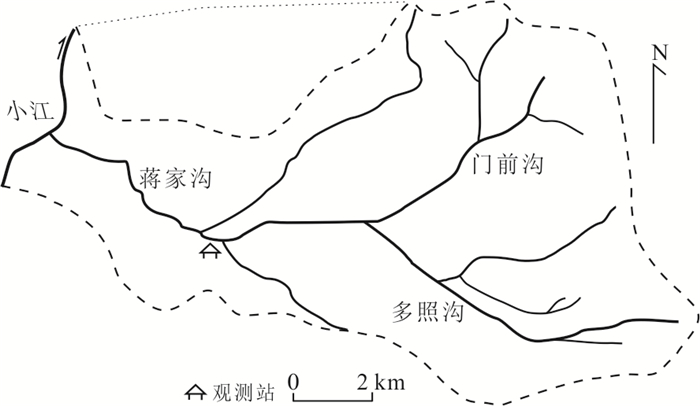
 下载:
下载:
